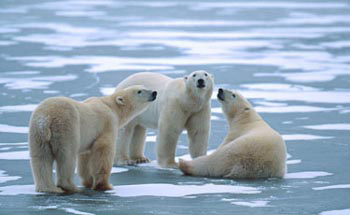Global climate changes in the past resulted in major shifts in biodiversity and marked reorganization of biological communities, landscapes, and biomes. For instance, and the at the Cretaceous-Tertiary boundary (one of the “Big Five” extinctions) some 65 million years ago, all the dinosaurs disappeared. However, these changes occurred in a landscape that was not as fragmented as it is today, and with little or no pressures from human activities. Current climate change coupled with other human pressures is stressing biodiversity at different levels imposed by the global climatic change that occurred in the evolutionary past.
Natural ecosystems appear to be the most vulnerable to the harmful effects of climate change, as there is often little that can be done to help them adapt to the projected speed and amount of change, (see the Amazon ). Some ecosystems that are already constrained by climate, such as alpine meadows are likely to face extreme stress, and biodiversity may disappear entirely in some places. It is likely that other more widespread ecosystems will also be vulnerable to climate change.
One of the climate scenarios is the potential for the forests to break up into a mosaic of forests, savannas, and grasslands. Major alterations to natural ecosystems due to climate change are likely to have negative consequences for our economy, which depends in part on the sustained bounty of our lands, waters, and native plant and animal communities.
It is possible that some species will adapt to changes in climate by shifting their ranges, although human and geographic barriers, and the presence of invasive non-native species will limit the degree of adaptation that can occur. Losses in local biodiversity are predicted to accelerate towards the end of the 21st century. However, studies are showing some species, like the Quiver Tree in Africa and Harlequin Frog of Central and South America are already threatened.
“Already resources are depleting, with the report showing that vertebrate species populations have declined by about one-third in the 33 years from 1970 to 2003. At the same time, humanity’s Ecological Footprint – the demand people place upon the natural world – has increased to the point where the Earth is unable to keep up in the struggle to regenerate.” WWF, October, 2006.
Projected climate changes also have the potential to become a major factor affecting marine living resources over the next few decades. The degree of the impact is likely to vary within a wide range, depending on the species and community characteristics and the regional specific conditions.
Importantly, temperature change-related effects in animals have been documented within all major taxonomic groups ( amphibians, birds, insects, mammals, reptiles , and invertebrates) and on all continents. As temperature rises, sea turtles may well face a similar fate to that of the dinosaur. Terrestrial evidence in animals that follows process-level understanding of responses to warming includes pole ward and elevational changes in spatial distribution, alterations in species abundance and diversity, earlier phenology (including advances in timing of reproduction), and physiological and genetic adaptations.

Species with wide non-patchy ranges, rapid dispersal mechanisms, and a large population normally are not in danger of extinction (e.g., European house sparrow and many weedy plant species). Those with narrow patchy ranges and small populations frequently are endangered and we need to adopt management strategies for their survival(e.g polar bears ). Species tend to become scarce when ranges shift from wide to narrow, the available habitat becomes patchier, and population size declines. Indeed, a species is likely to become extinct if it is forced into a narrow patchy range and its population declines.
Even when conservation management of rare species is effective, survival still may be problematic because in a small population, genetically similar individuals may breed, which decreases genetic variability. This, in turn, may reduce adaptability to stresses, thereby further lowering population size and decreasing the types of habitat within which the species could survive.
Environmental catastrophes such as hurricanes, oil spills, extreme temperatures, and drought can trigger the extinction of even well managed rare species. The only way to maintain biodiversity and reduce the risk of extinction brought about by catastrophes like climate change is to increase population sizes and maintain corridors between isolated populations.
Page updated 1 May 2010
|
Species Impacted Upon by Climate Change
|
